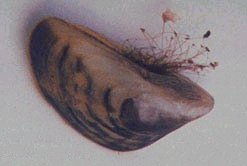Zebra and Quagga Mussels

Zebra and Quagga Mussels
(Dreissena polymorpha and Dreissena rostriformis bugensis)
Tags: Aquatic | EDRR
Identification and Reproduction
Identification:
- Zebra mussels grow up to 15 mm in size and have a “D-shaped” shell that can lay flat on surfaces.
- Their colour may vary from light to dark brown and the shell has obvious “zebra” striping.
- Quagga mussels grow up to 20 mm in size. Its shell is rounder in shape than the zebra mussel and does not sit flat.
- The colour of the quagga shell is pale near its hinge and usually features dark, concentric rings.
- Both these mussels are both fresh water mussels that both posess tough byssal threads, which our native mussels lack. These fibres are strong and sticky, allowing them to attach to rocks and other hard surfaces.
Reproduction:
- Both zebra and quagga are dioecious, which means male and female reproductive organs are found on separate individuals.
- Males and females release their eggs and sperm simultaneously into the water, where they become fertilized and develop into microscopic larvae (veligers).
- Within 2-3 weeks they start to develop their shells and byssal threads.
- They can produce about one million eggs in a spawning season.
Habitat & Ecology
- Zebra and quagga mussels will grow very quickly and cover a surface, they tend to be found in areas with high boat activity (ie. dock pilings, nearby buoys).
- With the help of their byssal threads, they easily attach to boats and water equipment.
- In cool and moist environments, zebra and quagga mussels can survive up to 30 days out of water.
- They are typically found in freshwater lakes, rivers, reservoirs, ponds and quarries that reach depths of 10-30 m, but have also been found in brackish waters.
- Currently, the zebra and quagga mussels have yet to establish in BC, Alberta Saskatchewan, Oregon, Idaho or Washington.
Impacts
- They can clog pipes of water treatment and power plants, disrupt ecosystems with large monocultures, and are difficult to remove.
- Invasive mussels pose a serious threat to the biodiversity and fisheries of water systems.
- As prolific filter feeders of plankton, they significantly reduce the amount of food available to native species.
- They can upset the balance of algae in an area, resulting in a higher concentration of blue-green algae and become toxic to aquatic life
- These two mussels can cause taste and odor problems in drinking water supplies.
- Their sharp shells will wash up on beaches and make it painful to walk barefoot and are very unpleasant for recreational users.
Management
- Learn how to identify zebra and quagga mussels and how to prevent accidentally spreading these invasive species.
- CLEAN DRAIN AND DRY YOUR WATERCRAFT!
- Inspect your boat, trailer and equipment after each use. Remove all plants, animals and mud before moving to a new waterbody.
- These species are listed under Prohibited Species and are illegal to possess, breed, transport or release.
- Drain water from motor, live well, bilge and transom wells while on land.
- Clean all recreational equipment with a high pressure wash, hot water, OR let it dry in the sun for at least 5 days.
- Please report all sightings of zebra and quagga mussels to the Report All Poachers and Polluters (RAPP) hotline: 1-877-952-7277
Resources
For more Zebra and Quagga Mussel Facts please refer to BC's factsheet on these invasive species here.
Download the Don't Move a Mussel factsheet on Zebra and Quagga Mussel here.
For more details on the identification and the impacts of Zebra and Quagga Mussels check out Ontario's Invading Species Awareness Program here.
Header photo (NOAA Great Lakes Environmental Research Laboratories).
Photo Gallery

×






